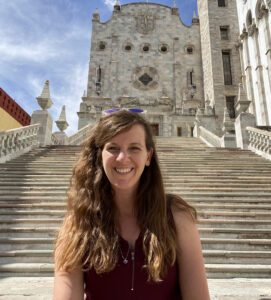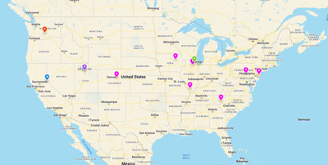
Fostering a Mindset for Disseminating Innovative Practice of K-12 Language Teachers
By Brianna Janssen Sánchez, Assistant Professor of World Languages Education, Southern Illinois University, Adjunct Assistant Professor, Summer Language Institute, Southern Oregon University

DOI: https://www.doi.org/10.69732/LCQX6892
Introduction
I am inspired daily by the in-service and pre-service teachers with whom I have the pleasure to work. I have been teaching for Southern Oregon University’s Summer Language Institute (SLI) for almost 10 years. In the SLI program, in-service Spanish teachers from across the United States pursue a Master of Arts in Spanish Language Teaching through a combination of online and in-person courses that take place on the campus of the University of Guanajuato in Guanajuato, Mexico. After finishing my doctoral degree program in Second Language Acquisition from the University of Iowa in 2015, I became the new Director of the Language Media Center (now called the Center for Language and Culture Learning) supporting postsecondary faculty in languages, and at the same time I began teaching for SLI. Coming from a background in post-secondary language teaching, I initially had a lot to learn about K-12 teacher education. What I found at that first session were passionate, eager, and forward-thinking teachers who consistently looked for ways to be agents for change in the classroom. For most, this is why they pursue the MA in Spanish Language Teaching.
The Technology in the Language Classroom course has gone through many iterations since I began teaching it in 2015, in line with the enormous changes in the educational and digital landscapes. It has been a fascinating experience to teach this course before, during, and after the COVID–19 pandemic; I have seen how language teaching and language teachers’ interests and abilities in using technologies to support teaching and learning languages have changed. My work with SLI has fueled my professional growth as a K-16 language teacher educator as well as my research interest in how teachers learn; how they implement pedagogical practice across diverse contexts; and how they are driven as teachers and leaders to respond to the needs of their students, schools, and communities. Picture 1 exemplifies the diverse locations in which the teachers in one of my SLI classes work, and the wide range sheds light on the potential impact of the geographical, social, and financial context of teachers’ pedagogical decision-making.

During my time teaching this graduate course, I have learned that: (1) teachers are dedicated to high-quality, equitable, and technology-enhanced education for their students; (2) teachers’ individual K-12 contexts drive their pedagogical decision-making, especially in regards to how they use technology in the classroom to support teaching and learning; and (3) teachers want to see themselves and their contexts represented in the support materials they interact with, including scholarly research and practice-based materials designed for teachers. Note that while I use the term teachers to reflect on the graduate students in the SLI program in general, when I discuss particular courses and interactions and assignments within a course, I refer to the teachers as students.
The Current Project
The inspiration behind the current project came from my growing understanding of the teaching situations of the world language teachers with whom I have worked in the Technology in the Language Classroom and other courses for SLI. In particular, K-12 teachers have regularly expressed to me that they and their students are rarely represented in the research and applications of technology in the language classroom. Recognizing that K-12 language teachers have different types of opportunities and challenges than postsecondary teachers, their perspectives highlight an issue in making connections from theory to post-secondary practice, and also to K-12 practice. For example, I can ask my students to interact via the Padlet platform for out-of-class engagement, but a K-12 teacher may not be able to use an online platform other than the one authorized by the school or district. A post-secondary teacher may engage students in writing social media posts, whereas a K-12 teacher may be strictly prohibited from doing so. I have also learned that while my students consistently produce exceptional work, most of the time it does not extend beyond my course or, in some cases, their school communities. In the best of cases, the teachers share their work with their SLI classmates or with colleagues at their schools. In exceptional cases, teachers develop and deliver professional development programs from their work in my courses and receive recognition for their excellence.
Combining my research interest in teacher agency and leadership with my professional and personal goal of amplifying the voices and the exceptional work of K-12 teachers, the focus of the course in 2023 was agency and dissemination. That focus led me to the current project. Students typically evaluate a technology application and write a review to develop abilities in technology evaluation to increase efficiency and effectiveness in making technology selections for teaching. In scrolling through social media sites for my own professional purposes, I often see calls for features and reviews from The FLTMAG and I think, “the teachers I work with are doing that…they are doing that too…” While preparing the course for the 2023 session, I contacted the The FLTMAG editorial board to ask whether they would be open to a group of contributions from K-12 teachers that highlighted their teaching contexts and perspectives. Given the warm welcome and encouragement from the The FLTMAG Editor-in-Chief, I designed the assignment so that teachers were encouraged to consider their individual contexts and interests, but also to select technological applications that were being solicited by The FLTMAG, but that had not already been selected for feature or review, or that had not been featured in ways they intended to implement them in their courses.
Students first viewed the The FLTMAG authorship support video and browsed articles published on the site to prepare for the task, which consisted of the following steps (1) select a relevant technology to review; (2) write an evaluation based on the features and potential uses of the tool in the language classroom; (3) design and implement an activity with the tool for use in their classroom; and (4) reflect on the implementation and offer future ideas for practice. The teachers were encouraged to write multimodal reviews that aligned with the The FLTMAG authorship guidelines and the style of current articles on the site. The following table shows the assignment guidelines presented to students.
| Web-based Tool Evaluation & Application
Syllabus description: Each student (or pair of students) will select one web-based tool that can be used to meet a specific objective in the world language classroom, create a multimodal evaluation of the tool using the evaluation models discussed in the course, explore applications in the K–12 Spanish classroom, and post a digital Canva summary to Padlet for student discussion. Guidelines: Use the guidelines found here to complete your assignment. In addition to everything found in these submission guidelines, you should try out an aspect of the tool (preferably one of the activity ideas you suggested) with your students. Include screenshots or images (if possible), and then write a one-paragraph reflection (integrating your thoughts and those of your students) of the implementation of the tool in your class. The assignment you submit should be about 750 words. Selecting your web-based tool: You can view the suggestions from The FLTMAG as well as the Technology Tools for Language Learning to make your selection. If you have ideas that are not listed on any of these sites, please consult with me before making your selection. |
In addition to investigating their selected web-based tool, the students designed activities to implement their respective tools in their classrooms. This application step enabled them to report on the use of the tool, reflect on general language teaching ideas and implementations, and also to give voice to challenges and opportunities specific to the K-12 language teaching context. The teachers experienced challenges in carrying out the application phase of the assignment, including school regulations for technology usage, school-implemented firewalls, and demanding schedules that left little time for designing and carrying out the tool-based activity. Meeting these challenges required, in some cases, opting for a different technological tool, using their scant free time to study the style and formatting of The FLTMAG published articles, or sacrificing instructional time to prepare their students for the implementation activity. All of the teachers reported having to move outside their routines and, in many cases, their comfort zones, as they adopted an attitude of exploration and critical inquiry.
As they revised their assignments for publication, I provided support in interpreting the results of their implementation activity, following the guidelines of The FLTMAG, and editing their articles. Students also provided peer support in a collaborative Padlet where they shared their multimodal visuals created with Canva and discussed their experiences with implementing new technologies in various K–12 contexts.

Picture 2 represents the collaborative technology evaluation discussion on Padlet that has been anonymized with comments removed for privacy of those students who did not publish articles. They provided rich and thoughtful comments on the work of their classmates, shared their experiences in implementing their application activities, and offered assessments of other tools they have used for similar teaching objectives.
The process of writing for publication in The FLTMAG extended well beyond the SLI course, which required substantial additional commitment by the students (and by me, their instructor). In all, eight of the students in the course were able to bring their course projects to publishable quality. This project has had an impact on all eight authors as agents for pedagogical change in the classroom and in the wider language teaching community. In addition, these articles are their first publications. They took the initiative to connect what they learned in a graduate course to their teaching practice, and they dedicated their limited free time to see this project through. They took pride in their work and in their professional development as teachers as they engaged with their students in hands-on learning and then disseminated their experiences to a wider professional audience. Their articles also serve as tangible evidence of the importance of their graduate studies for performance reviews at their schools and in future career advancement. Finally, it is important that we hear the voices of the K-12 teachers, who represent such a large percentage of the language teaching profession. This project has shed light on the excellent work in K-12 technology-enhanced language classrooms and has presented valuable examples of how technology can be implemented in a wide range of teaching and learning contexts.
The following seven articles represent an innovative mix of technological tools, application activities, and K-12 teaching contexts:
Jenna Bacchi: Engaging Students with Readings from Commonlit
Katie Lattin: Lectia: A World of Language Learning in Students’ Hands
Macon Looper: Designing Customized Websites with Google Sites: Providing Space for Voice and Choice in the Classroom
Martha Arrizon: How Can WL Teachers Use DocHub in the Classroom?
Claire Nightingale: Lingostar.ai: Revolutionizing Language Learning with AI Technology
